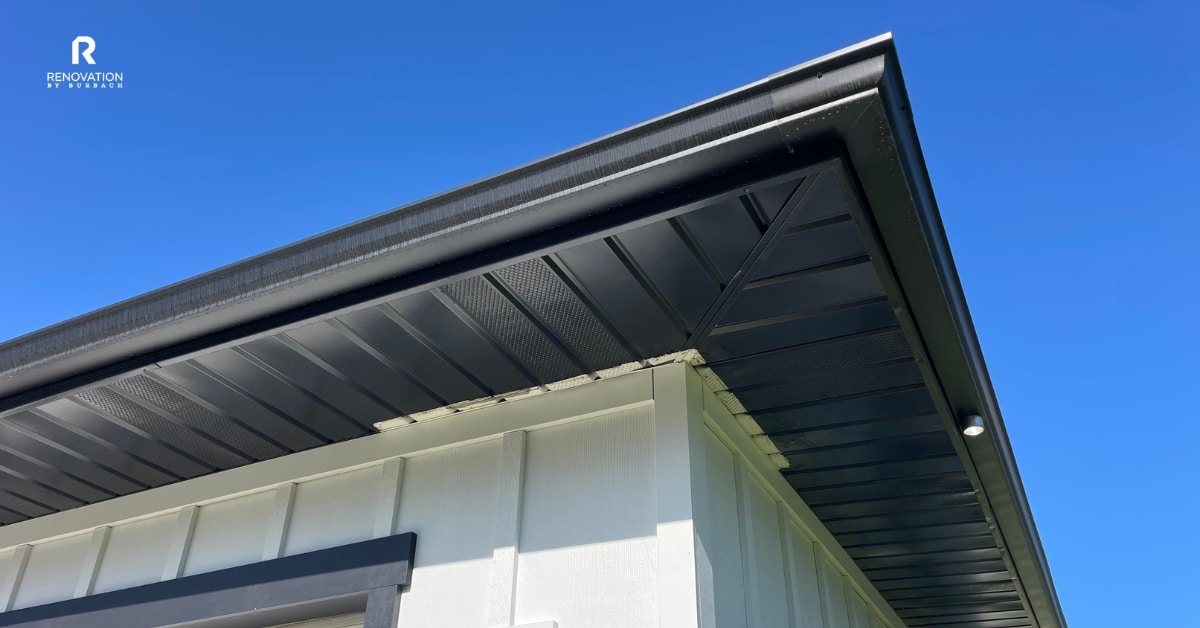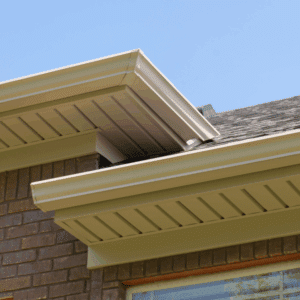Why Soffit and Fascia Confuse So Many Homeowners
You’ve probably looked up at your roofline and wondered, “What’s the difference between those boards and panels under the edge?” You’re not alone. Many homeowners in Utah and beyond confuse soffit with fascia, even though both play a huge role in protecting and finishing your home. If your siding looks tired, your gutters sag, or you’re worried about curb appeal, understanding soffit vs fascia is the first step to making the right improvements. In this guide, we’ll break down the difference, why each matters, and how to choose the best materials so your home looks sharp and stays protected for years to come.
What We’ll Cover
What is a Soffit?
The soffit is the horizontal panel tucked under the overhanging edge of your roof. Think of it as the “ceiling” of your eaves. It’s not just decorative; it helps your attic breathe. Ventilated soffit panels allow air to circulate, reducing moisture, mold, and ice dam problems.
Soffits are usually made from materials like vinyl, aluminum, wood, or fiber cement. Each option comes with its own strengths:
-
- Vinyl: Affordable, low-maintenance, wide range of colors.
-
- Aluminum: Durable, lightweight, and rot-resistant.
-
- Wood: Traditional look but requires regular upkeep.
-
- Fiber cement (like James Hardie): Extremely durable, weather-resistant, and stylish.
What is Fascia?
Fascia is the vertical finishing board that caps the end of your roof rafters. It runs along the roof edge and is what your gutters attach to. Without strong fascia, gutters sag and water damage follows.
Fascia boards also frame the roofline, giving your home a crisp, clean edge. Just like soffit, materials vary:
-
- Wood: Classic appearance but prone to rot if not maintained.
-
- Aluminum or vinyl wrap: Adds protection and reduces upkeep.
-
- Fiber cement: Strong, weather-resistant, long lifespan.
Soffit vs Fascia: The Difference Explained
Here’s the simplest way to remember:
-
- Soffit = Underneath (horizontal, provides airflow).
-
- Fascia = Front-facing (vertical, holds gutters and finishes the roofline).
Together, they protect your home’s structure from water, pests, and rot while improving curb appeal. One without the other leaves your home vulnerable.
Why Soffit and Fascia Matter for Your Home
Skipping or ignoring soffit and fascia leads to expensive issues:
-
- Moisture buildup in the attic without ventilation.
-
- Rotting roof edges where water seeps in.
-
- Pest entry points around gaps and holes can be prevented by proper soffits.
-
- Sagging gutters that pull away during heavy rain.
-
- Lost curb appeal when boards crack, peel, or warp.
If you’re planning to sell your home or simply want peace of mind, upgrading soffit and fascia is one of the smartest exterior investments you can make.
Choosing the Right Material for Utah Homes
Utah weather swings from snowy winters to blazing summers. Materials that work in mild climates don’t always hold up here. Here’s what to weigh:
-
- Durability: Fiber cement soffit and fascia handle extreme weather better than vinyl.
-
- Maintenance: Wrapped aluminum fascia and ventilated vinyl soffit cut down on upkeep.
-
- Aesthetics: Brick, stone, and James Hardie siding pair beautifully with updated soffit and fascia colors.
-
- Energy efficiency: Ventilated soffits improve airflow, lowering cooling costs in summer.
Signs Your Soffit and Fascia Need Attention
Watch for these red flags:
-
- Paint peeling or boards cracking.
-
- Gutters are pulling away from the roofline.
-
- Mold, mildew, or water stains on ceilings.
-
- Birds, squirrels, or insects are getting into the attic.
-
- Visible sagging or warping under the roof edge.
If you notice any of these, replacement or repair should be on your radar.
Professional Installation vs DIY
DIY videos make soffit and fascia replacement look simple, but mistakes are costly. Misaligned panels or poorly secured fascia can cause water damage fast.
Professional installers:
-
- Ensure proper ventilation and airflow.
-
- Use materials that last in your region.
-
- Install gutters correctly on the fascia.
-
- Finish the look for a crisp, polished result.
At Renovation By Burbach, our team has helped thousands of homeowners across Salt Lake City, Ogden, Park City, and beyond protect their homes with soffit and fascia upgrades that look as good as they perform. For broader projects, see this take on DIY vs professional installation.
Built on Experience You Can Trust
Renovation By Burbach isn’t new to this. From James Hardie siding installations to full exterior remodels, we’ve seen firsthand how soffit and fascia impact a home’s longevity and design. Our visualizer tool even lets you see the transformation before committing.
Ready to Improve Your Roofline?
A small upgrade, such as soffit and fascia replacement, can transform your home’s appearance and performance. If you’re already updating siding or gutters, it’s the perfect time to handle soffit and fascia, too.
✅ Ready to see your options? Or explore our exterior services today.
FAQs About Soffit and Fascia
Make Your Home Stand Out with Renovation By Burbach
Soffit and fascia may seem like small details, but they play a big role in protecting your home and boosting curb appeal. By choosing the right materials and expert installation, you protect your investment, improve efficiency, and transform your home’s appearance.
Thinking about updating your exterior? Start with soffit and fascia. Then explore siding, windows, and stonework to complete the picture.
✅ Take the next step: Schedule a free consultation with Renovation By Burbach and see how we can help bring your home’s potential to life.
Related Reads:
- What is a Soffit vs Fascia? - October 10, 2025
- What’s the Difference Between Soffit and Fascia? A Home Exterior Guide for Utah Homeowners - June 30, 2025
- Are Rain Gutters Really Necessary? What Utah Homeowners Need to Know - June 6, 2025





